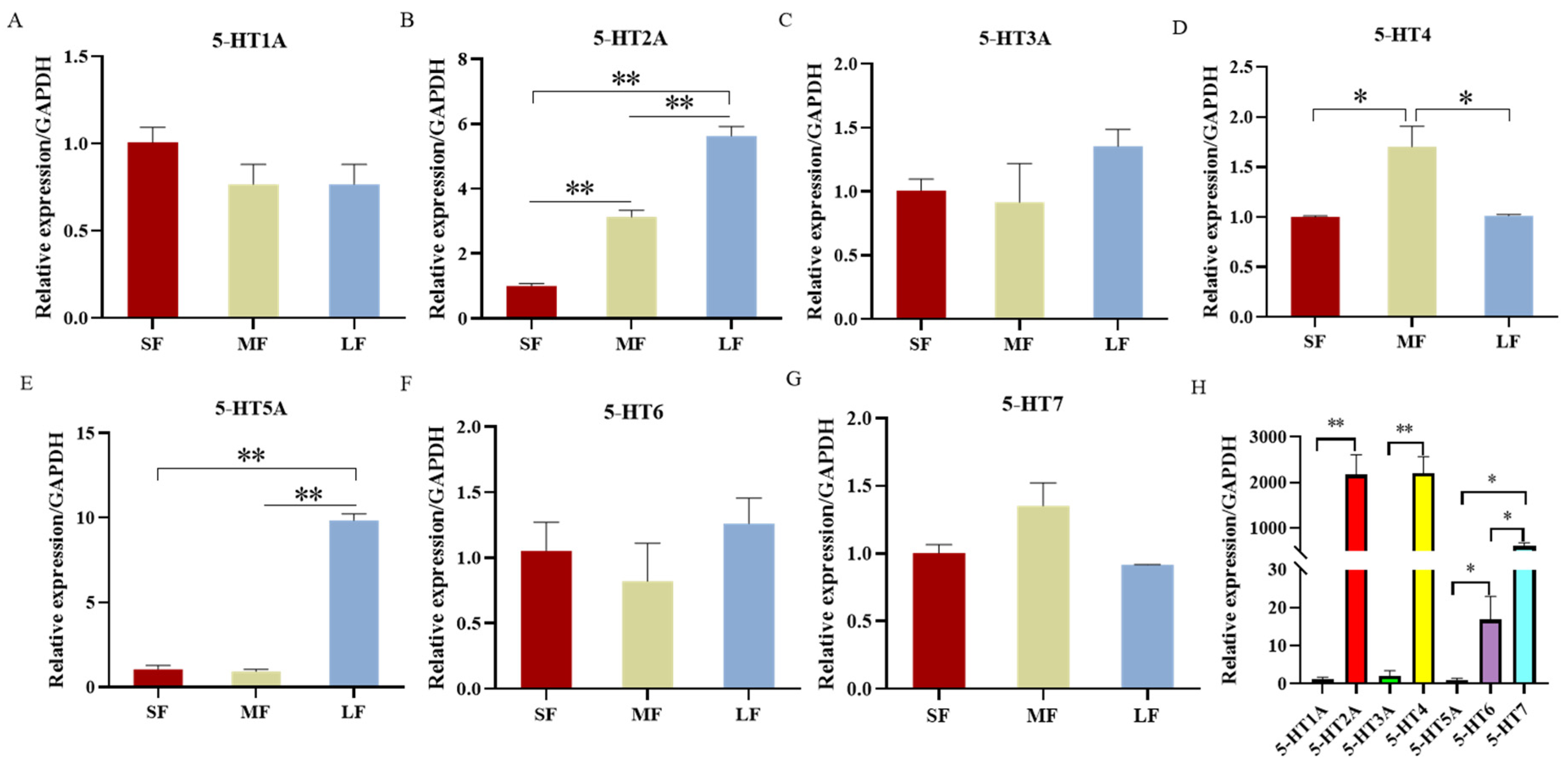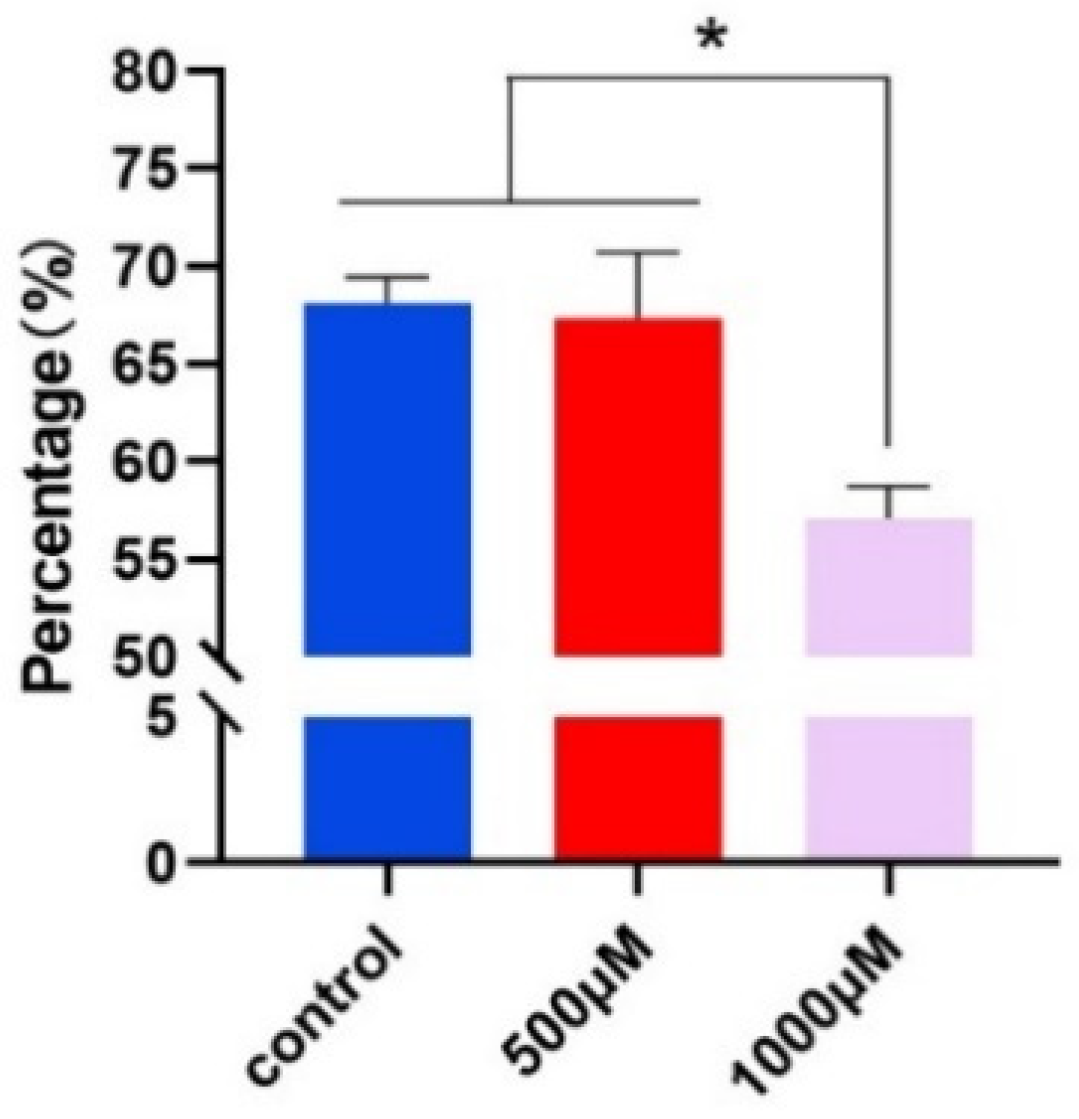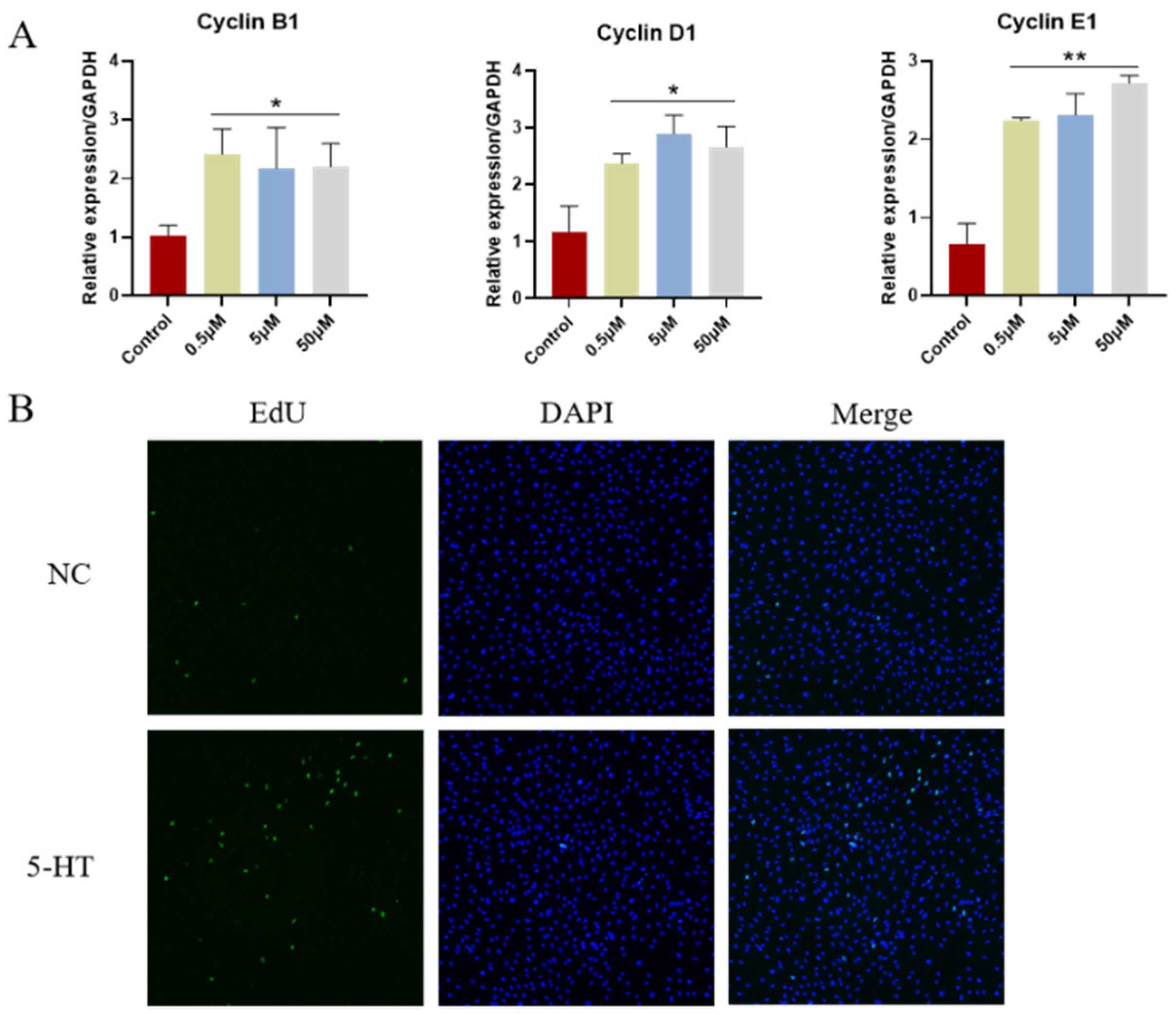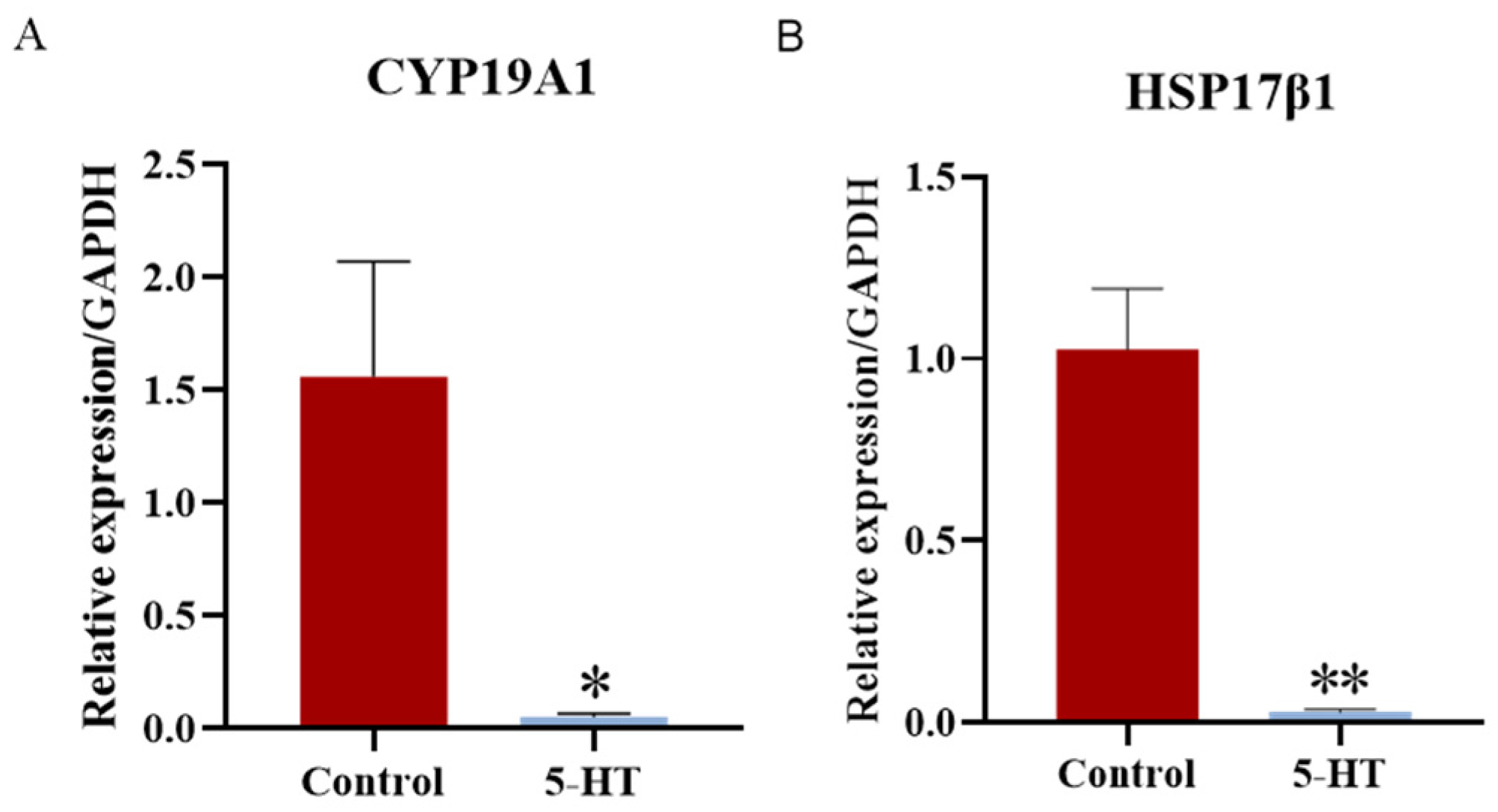Effect of Serotonin (5-Hydroxytryptamine) on Follicular Development in Porcine
Abstract
1. Introduction
2. Results
2.1. The Content of 5-HT in Follicles of Different Sizes
2.2. Expression of 5-HT Receptors in the Ovary, Follicles and Granulosa Cells in Porcine
2.3. Effect of 5-HT on Oocyte Maturation
2.4. Effect of 5-HT on Porcine Granulosa Cells
2.5. 5-HT Exposure Reduces the Expression of 5-HT Receptors
2.6. 5-HT Exposure Inhibits E2 Synthesis in GCs
3. Discussion
4. Materials and Methods
4.1. Collection of Tissues
4.2. Follicles Classification
4.3. Isolation and Culture of Porcine Granulosa Cells
4.4. Oocytes Collection and In Vitro Culture
4.5. RNA Isolation and Quantitative Real-Time PCR
4.6. ELISA
4.7. EdU Staining
4.8. Statistical Analysis
5. Conclusions
Author Contributions
Funding
Institutional Review Board Statement
Informed Consent Statement
Data Availability Statement
Conflicts of Interest
References
- Stringer, J.M.; Alesi, L.R.; Winship, A.L.; Hutt, K.J. Beyond apoptosis: Evidence of other regulated cell death pathways in the ovary throughout development and life. Hum. Reprod. Update 2023, 29, 434–456. [Google Scholar] [CrossRef] [PubMed]
- Xiao, S.; Zhang, J.; Liu, M.; Iwahata, H.; Rogers, H.B.; Woodruff, T.K. Doxorubicin Has Dose-Dependent Toxicity on Mouse Ovarian Follicle Development, Hormone Secretion, and Oocyte Maturation. Toxicol. Sci. 2017, 157, 320–329. [Google Scholar] [CrossRef]
- McGee, E.A.; Hsueh, A.J.W. Initial and cyclic recruitment of ovarian follicles. Endocr. Rev. 2000, 21, 200–214. [Google Scholar] [CrossRef] [PubMed]
- Knox, R.V. Follicle development in pigs: State of the art. Mol. Reprod. Dev. 2022, 90, 480–490. [Google Scholar] [CrossRef] [PubMed]
- Liu, S.; Jia, Y.; Meng, S.; Luo, Y.; Yang, Q.; Pan, Z. Mechanisms of and Potential Medications for Oxidative Stress in Ovarian Granulosa Cells: A Review. Int. J. Mol. Sci. 2023, 24, 9205. [Google Scholar] [CrossRef]
- Chen, S.; Wu, R.-F.; Su, L.; Zhou, W.-D.; Zhu, M.-B.; Chen, Q.-H. Lipoxin A4 regulates expression of the estrogen receptor and inhibits 17β-E2 induced p38 mitogen-activated protein kinase phosphorylation in human endometriotic stromal cells. Fertil. Steril. 2014, 102, 264–271. [Google Scholar] [CrossRef] [PubMed]
- Hershlag, A.; Lesser, M.; Montefusco, D.; Lavy, G.; Kaplan, P.; Liu, H.C.; Rosenfeld, D. Interinstitutional variability of follicle-stimulating hormone and E2 levels. Fertil. Steril. 1992, 58, 1123–1126. [Google Scholar] [CrossRef] [PubMed]
- Britt, K.L.; Drummond, A.E.; Cox, V.A.; Dyson, M.; Wreford, N.G.; Jones, M.E.E.; Simpson, E.R.; Findlay, J.K. An age-related ovarian phenotype in mice with targeted disruption of the Cyp 19 (aromatase) gene. Endocrinology 2000, 141, 2614–2623. [Google Scholar] [CrossRef]
- Amireault, P.; Sibon, D.; Côté, F. Life without Peripheral Serotonin: Insights from Tryptophan Hydroxylase 1 Knockout Mice Reveal the Existence of Paracrine/Autocrine Serotonergic Networks. ACS Chem. Neurosci. 2012, 4, 64–71. [Google Scholar] [CrossRef]
- Mohammad-Zadeh, L.F.; Moses, L.; Gwaltney-Brant, S.M. Serotonin: A review. J. Vet. Pharmacol. Ther. 2008, 31, 187–199. [Google Scholar] [CrossRef]
- Barnes, N.M.; Ahern, G.P.; Becamel, C.; Bockaert, J.; Camilleri, M.; Chaumont-Dubel, S.; Claeysen, S.; Cunningham, K.A.; Fone, K.C.; Gershon, M.; et al. International Union of Basic and Clinical Pharmacology. CX. Classification of Receptors for 5-hydroxytryptamine; Pharmacology and Function. Pharmacol. Rev. 2021, 73, 310–520. [Google Scholar] [CrossRef] [PubMed]
- Chaiyamoon, A.; Tinikul, R.; Chaichotranunt, S.; Poomthong, T.; Suphamungmee, W.; Sobhon, P.; Tinikul, Y. Distribution and dynamic expression of serotonin and dopamine in the nervous system and ovary of Holothuria scabra during ovarian maturation. J. Comp. Physiol. A 2018, 204, 391–407. [Google Scholar] [CrossRef] [PubMed]
- Terranova, P.F.; Uilenbroek, J.T.; Saville, L.; Horst, D.; Nakamura, Y. Serotonin enhances oestradiol production by hamster preovulatory follicles in vitro: Effects of experimentally induced atresia. J. Endocrinol. 1990, 125, 433–438. [Google Scholar] [CrossRef] [PubMed]
- Battista, P.J.; Rexroad, C.E., Jr.; Condon, W.A. Mechanisms involved in the action of serotonin-induced stimulation of progesterone production by bovine luteal cells in vitro. Mol. Cell. Endocrinol. 1987, 51, 145–151. [Google Scholar] [CrossRef]
- Koppan, M.; Bodis, J.; Verzar, Z.; Tinneberg, H.R.; Torok, A. Serotonin may alter the pattern of gonadotropin-induced progesterone release of human granulosa cells in superfusion system. Endocrine 2004, 24, 155–159. [Google Scholar] [CrossRef]
- Han, Y.; Zhang, M.; Duan, J.; Li, L.; Du, J.; Cheng, H.; Zhang, S.; Zhai, Y.; An, X.; Li, Q.; et al. Maternal Prepregnancy 5-Hydroxytryptamine Exposure Affects the Early Development of the Fetus. Front. Physiol. 2022, 13, 761357. [Google Scholar] [CrossRef]
- Wu, J.; Tian, Q. Role of follicle stimulating hormone and epidermal growth factor in the development of porcine preantral follicle in vitro. Zygote 2007, 15, 233–240. [Google Scholar] [CrossRef] [PubMed]
- Sosa, A.; Ortega-Corona, B.G.; Chargoy, J.; Vargas, J.; Hernandez, O.; Rosado, A. Presence of biogenic amines in human follicular fluid and seminal plasma. Acta Cient. Venez. 1988, 39, 245–248. [Google Scholar]
- Acharya, S.B.; Goswami, N.G.; Debnath, P.K. Uterine and placental 5-HT profile in different gestational period of albino rats. Indian J. Exp. Biol. 1989, 27, 505–509. [Google Scholar]
- Amireault, P.; Dubé, F. Serotonin and its antidepressant-sensitive transport in mouse cumulus-oocyte complexes and early embryos. Biol. Reprod. 2005, 73, 358–365. [Google Scholar] [CrossRef] [PubMed]
- Graveleau, C.; Paust, H.J.; Schmidt-Grimminger, D.; Mukhopadhyay, A.K. Presence of a 5-HT7 receptor positively coupled to adenylate cyclase activation in human granulosa-lutein cells. J. Clin. Endocrinol. Metab. 2000, 85, 1277–1286. [Google Scholar] [CrossRef] [PubMed]
- Neilson, L.; Andalibi, A.; Kang, D.; Coutifaris, C.; Strauss, J.F.; Stanton, J.A.L.; Green, D.P.L. Molecular phenotype of the human oocyte by PCR-SAGE. Genomics 2000, 63, 13–24. [Google Scholar] [CrossRef] [PubMed]
- Amireault, P.; Dubé, F. Intracellular cAMP and calcium signaling by serotonin in mouse cumulus-oocyte complexes. Mol. Pharmacol. 2005, 68, 1678–1687. [Google Scholar] [CrossRef] [PubMed]
- Hinckley, M.; Vaccari, S.; Horner, K.; Chen, R.; Conti, M. The G-protein-coupled receptors GPR3 and GPR12 are involved in cAMP signaling and maintenance of meiotic arrest in rodent oocytes. Dev. Biol. 2005, 287, 249–261. [Google Scholar] [CrossRef]
- Fujiwara, T.; Nakada, K.; Shirakawa, H.; Miyazaki, S. Development of inositol trisphosphate-induced calcium release mechanism during maturation of hamster oocytes. Dev. Biol. 1993, 156, 69–79. [Google Scholar] [CrossRef]
- Cheng, J.C.; Fang, L.L.; Yan, Y.; He, J.Y.; Guo, Y.J.; Jia, Q.Q.; Gao, Y.B.; Han, X.Y.; Sun, Y.P. TGF-β1 stimulates aromatase expression and E2 production through SMAD2 and ERK1/2 signaling pathways in human granulosa-lutein cells. J. Cell. Physiol. 2021, 236, 6619–6629. [Google Scholar] [CrossRef] [PubMed]
- Quirk, S.M.; Cowan, R.G.; Harman, R.M. The susceptibility of granulosa cells to apoptosis is influenced by oE2 and the cell cycle. J. Endocrinol. 2006, 189, 441–453. [Google Scholar] [CrossRef] [PubMed]
- Tanaka, E.; Baba, N.; Toshida, K.; Suzuki, K. Serotonin stimulates steroidogenesis in rat preovulatory follicles: Involvement of 5-HT2 receptor. Life Sci. 1993, 53, 563–570. [Google Scholar] [CrossRef] [PubMed]
- Yang, C.K.; Wu, R.S.C.; Wu, C.H.; Lin, T.R.Y.; Tsai, H.D. Sleep deprivation enhances peripheral serotonin secretion to regulate the large follicle steroidogenesis of rats. Taiwan. J. Obstet. Gynecol. 2015, 54, 260–265. [Google Scholar] [CrossRef]
- Leonov, B.V.; Kamakhin, A.P.; Buznikov, G.A. Effect of serotonin and antiserotonin preparations on the development of early stages of mice embryos cultivated in vitro. Dokl. Akad. Nauk. SSSR 1969, 188, 958–960. [Google Scholar]
- Liu, Y.; Yang, Y.; Li, W.; Ao, H.; Zhang, Y.; Zhou, R.; Li, K. Effects of melatonin on the synthesis of estradiol and gene expression in pig granulosa cells. J. Pineal Res. 2019, 66, e12546. [Google Scholar] [CrossRef]
- Zhao, J.; Ross, J.W.; Hao, Y.; Spate, L.D.; Walters, E.M.; Samuel, M.S.; Rieke, A.; Murphy, C.N.; Prather, R.S. Significant Improvement in Cloning Efficiency of an Inbred Miniature Pig by Histone Deacetylase Inhibitor Treatment after Somatic Cell Nuclear Transfer. Biol. Reprod. 2009, 81, 525–530. [Google Scholar] [CrossRef]






| Follicular Grading | Follicle Diameter |
|---|---|
| SF | 2–3 mm |
| MF | 3–5 mm |
| LF | 5–6 mm |
| Primer | Primer Pair Sequences (5′ to 3′) | Product Size (bp) |
|---|---|---|
| Cyclin B1 | F: AATCCCTTCTTGTGGTTA | 104 |
| R: CTTAGATGTGGCATACTTG | ||
| Cyclin D1 | F: TACACCGACAACTCCATCCG | 224 |
| R: GAGGGCGGGTTGGAAATGAA | ||
| Cyclin E1 | F: AGAAGGAAAGGGATGCGAAGG | 173 |
| R: CCAAGGCTGATTGCCACACT | ||
| CYP19A1 | F: TCCGCAATGACTTGGGCTAC | 103 |
| R: GCCTTTTCGTCCAGTGGGAT | ||
| HSP17β1 | F: CCGAGCACCAAAGAGTGTTC | 131 |
| R: TTATTGCGGGGTGGCAAGAG | ||
| 5-HT1A | F: TGCGTCCCCACCTCCTTCAAG | 102 |
| R: GATGCCCAGCGTCTTCACAGTC | ||
| 5-HT2A | F: TCTTCCAGCGGTCCATCCACAG | 129 |
| R: GGCACCACATCACCACGAACAG | ||
| 5-HT3A | F: TGACCTCCATCCGGCACTTCC | 122 |
| R: CAGCACAGCCAGCAGGTAGATTC | ||
| 5-HT4 | F: CGCATCTACGTGACAGCTAAGGAG | 177 |
| R: CCAGCAGAGGCAGAAGCAACC | ||
| 5-HT5A | F: CCTCCTGTGGCTCGGCTACTC | 80 |
| R: AGGTGCTGTTGTCGTGCTTGTC | ||
| 5-HT6 | F: TTGGACTTGGACTCGGACTCAGG | 134 |
| R: TTGAAGACGTTGACTGCGGTAGTG | ||
| 5-HT7 | F: CCGTCAGGCAGAATGGCAAGTG | 164 |
| F: CCGTCAGGCAGAATGGCAAGTG |
Disclaimer/Publisher’s Note: The statements, opinions and data contained in all publications are solely those of the individual author(s) and contributor(s) and not of MDPI and/or the editor(s). MDPI and/or the editor(s) disclaim responsibility for any injury to people or property resulting from any ideas, methods, instructions or products referred to in the content. |
© 2024 by the authors. Licensee MDPI, Basel, Switzerland. This article is an open access article distributed under the terms and conditions of the Creative Commons Attribution (CC BY) license (https://creativecommons.org/licenses/by/4.0/).
Share and Cite
Zhang, Y.; Han, Y.; Yang, R.; Zhang, B.-Y.; Zhao, Y.-S.; Wang, Y.-Q.; Jiang, D.-Z.; Wang, A.-T.; Zhang, X.-M.; Tang, B. Effect of Serotonin (5-Hydroxytryptamine) on Follicular Development in Porcine. Int. J. Mol. Sci. 2024, 25, 9596. https://doi.org/10.3390/ijms25179596
Zhang Y, Han Y, Yang R, Zhang B-Y, Zhao Y-S, Wang Y-Q, Jiang D-Z, Wang A-T, Zhang X-M, Tang B. Effect of Serotonin (5-Hydroxytryptamine) on Follicular Development in Porcine. International Journal of Molecular Sciences. 2024; 25(17):9596. https://doi.org/10.3390/ijms25179596
Chicago/Turabian StyleZhang, Yan, Yu Han, Rui Yang, Bo-Yang Zhang, Yan-Sen Zhao, Yue-Qi Wang, Dao-Zhen Jiang, An-Tong Wang, Xue-Ming Zhang, and Bo Tang. 2024. "Effect of Serotonin (5-Hydroxytryptamine) on Follicular Development in Porcine" International Journal of Molecular Sciences 25, no. 17: 9596. https://doi.org/10.3390/ijms25179596
APA StyleZhang, Y., Han, Y., Yang, R., Zhang, B.-Y., Zhao, Y.-S., Wang, Y.-Q., Jiang, D.-Z., Wang, A.-T., Zhang, X.-M., & Tang, B. (2024). Effect of Serotonin (5-Hydroxytryptamine) on Follicular Development in Porcine. International Journal of Molecular Sciences, 25(17), 9596. https://doi.org/10.3390/ijms25179596








